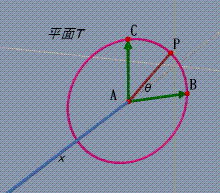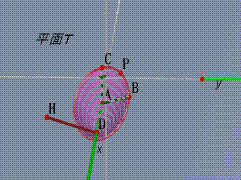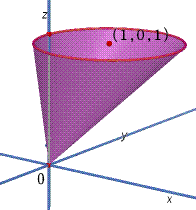|
問題3 $xyz$空間の3点 $A(5,0,0),B(4,1,0),C(5,0,\sqrt{2})$ が定める平面を$T$,$T$上にあって点$A$を中心として半径$\sqrt{2}$をもつ円を$U$とする. このとき,以下の問いに答えよ. (1) 点$P$は円$U$の周上にある. $\angle {PAB}=\theta \ \ \ (0 \leqq \theta \text{<}2\pi)$ とするとき,$P$の座標$(u,v,r)$ を$\theta $を用いて表せ. (2) 2$点D(10,0,0),P$を通る直線が$yz$平面と交わる点を$Q(0,Y,Z)$とする.$Y$と$Z$を$\theta $を用いて表せ. (3) (2)の$Y,Z$から$\theta $を消去して,$Q$の軌跡が楕円となることを示せ.またその楕円の概形を$yz$平面上の図示せよ  この問題で,空間における円の取り扱いを学びましょう.
この問題で,空間における円の取り扱いを学びましょう.なお,この問題で扱う円錐は斜円錐ですが,解説で斜円錐の方程式を求めますが,その方程式は2次式ですから, 斜円錐の平面による切り口の曲線は2次曲線以外現れません. 解答 $(1) \ \ \overrightarrow{AB}=(-1,1,0),\overrightarrow{AC}=(0,0,\sqrt{2})$ より $|\overrightarrow{AB}|=|\overrightarrow{AB}|=\sqrt{2},\overrightarrow{AB}\perp \overrightarrow{AB}$ であるので, $\overrightarrow{OP}=\overrightarrow{OA}+\cos \theta \overrightarrow{AB}+\sin\theta \overrightarrow{AC}$ $=(5-\cos \theta ,\cos \theta ,\sqrt{2}\sin \theta)$  $(2) \ \ \overrightarrow{DQ}=t\overrightarrow{DP}$
$(2) \ \ \overrightarrow{DQ}=t\overrightarrow{DP}$より $(-10,Y,Z)=t(-5-\cos \theta ,\cos \theta ,\sqrt{2}\sin \theta)$ したがって, $t=\dfrac{10}{5+\cos \theta},Y=t\cos \theta ,Z=\sqrt{2}t\sin \theta$ $\therefore Y=\dfrac{10\cos \theta}{5+\cos \theta},Z=\dfrac{10\sqrt{2}\sin \theta}{5+\cos \theta}$ $(3) \ \cos \theta ,\sin \theta$を$Y,Z$について解いて $\cos ^2 \theta +\sin ^2 \theta =1$ に代入する. $\cos \theta =\dfrac{5Y}{10-Y},\sin \theta =\dfrac{5Z}{\sqrt{2}(10-Y)}$ より,求める曲線は楕円でその方程式は $Y^2+\dfrac{Z^2}{2}=\dfrac{(10-Y)^2}{25}$ である. 解説 $1. \ \ $円の媒介変数表示について説明を付け加えます. $xy$平面上の原点を中心とする半径1の円は $(\cos \theta ,\sin \theta)$ と表示されます. したがって, $ \begin{pmatrix} \cos \theta \\ \sin \theta \end{pmatrix} =\cos \theta \begin{pmatrix} 1 \\ 0 \end{pmatrix} +\sin \theta \begin{pmatrix} 0 \\ 1 \end{pmatrix} \ \ \cdots \text{①}$ です.①を原点の周りに$\alpha $回転させても変りませんから,原点を中心とする半径1の円は $\begin{pmatrix} \cos \alpha & -\sin \alpha \\ \sin \alpha & \cos \alpha \end{pmatrix} \begin{pmatrix} \cos \theta \\ \sin \theta \end{pmatrix} =\cos \theta \begin{pmatrix} \cos \alpha \\ \sin \alpha \end{pmatrix} +\sin \theta \begin{pmatrix} -\sin \alpha \\ \cos \alpha \end{pmatrix}$ したがって,直交する単位ベクトル$\overrightarrow{u},\overrightarrow{v}$を $\overrightarrow{u}= \begin{pmatrix} \cos \alpha \\ \sin \alpha \end{pmatrix}, \overrightarrow{v}= \begin{pmatrix} -\sin \alpha \\ \cos \alpha \end{pmatrix}$ とおけば,原点を中心とする半径1の円は $\cos \theta \overrightarrow{u}+\sin \theta \overrightarrow{v}$ と表せることが分かりました. 次に①を$x$軸に関する対称移動をすると, $\cos \theta \begin{pmatrix} 1 \\ 0 \end{pmatrix} +\sin \theta \begin{pmatrix} 0 \\ -1 \end{pmatrix} \ \ \ \cdots \text{②}$ ②を回転しても当然原点を中心とする半径1の円ですから,$\overrightarrow{u},\overrightarrow{v}$を逆にとっても かまわないことがわかります.すなわち,原点を中心とする半径1の円は平面上の直交する2つの単位ベクトル $\overrightarrow{u},\overrightarrow{v}$ を用いて, $\cos \theta \overrightarrow{u}+\sin \theta \overrightarrow{v}$ と表せることが分かりました. もちろん $x\overrightarrow{u}+y\overrightarrow{v} \ \ (x^2+y^2=1)$ でもかまいません. なお対応する点は$\theta$が$0$から$2\pi$まで動くとき,$\overrightarrow{u}$の終点から $\overrightarrow{v}$の終点に向かって動き一周します. さらに,$A(\overrightarrow{a})$を中心とする半径$r$の円上の点$P(\overrightarrow{p})$は $\overrightarrow{p}=\overrightarrow{a}+r\cos \theta \overrightarrow{u}+r\sin \theta \overrightarrow{v}$ となります. $2. \ \ $ 空間内の平面上に2つのベクトル$\overrightarrow{u},\overrightarrow{v}$が与えられたとき,直交する単位ベクトルを作るには $\overrightarrow{e_1}=\dfrac{\overrightarrow{u}}{|\overrightarrow{u}|}$ さらに $(t\overrightarrow{u}+s\overrightarrow{v})\cdot \overrightarrow{e_1}=0,|t\overrightarrow{u}+s\overrightarrow{v}|=1$ より$\overrightarrow{e_2}$を求めることになりますが,もしも外積の知識があれば, $\overrightarrow{e_1}=\dfrac{\overrightarrow{u}}{|\overrightarrow{u}|}$ $\overrightarrow{n}=\dfrac{\overrightarrow{u}\times \overrightarrow{u}}{|\overrightarrow{u}\times \overrightarrow{u}|}$ $\overrightarrow{e_2}=\overrightarrow{n}\times \overrightarrow{e_1}$ より得られる$\overrightarrow{e_1},\overrightarrow{e_2}$が平面上の直交する単位ベクトルです.さらに, $\{ \overrightarrow{e_1},\overrightarrow{e_2},\overrightarrow{n}\}$ が与えられた平面の右手系をなす互い直交する単位ベクトルです.  $3. \ \ $この問題で扱われる円錐は斜円錐です.斜円錐の方程式を求めよう.ここでは,頂点が原点,底面の円が
$3. \ \ $この問題で扱われる円錐は斜円錐です.斜円錐の方程式を求めよう.ここでは,頂点が原点,底面の円が$(x-1)^2+y^2=1,z=1$ である斜円錐の方程式を求める. この斜円錐を平面$z=t$で切ると $(x-t)^2+y^2=t^2,z=t$ $t$を消去して $(x-z)^2+y^2=z^2$ となる.注目することは,$x,y,z$の2次式であることです.一般の斜円錐でも,底面の円が$z=1$上にあるようにとれば, 円の中心と半径が異なるだけですから, 2次式であることが分かります.一方平面の方程式は1次式であるから,斜円錐を平面で切ったときの切り口は2次曲線になります. なお斜円錐は立体図形の入試問題1.問題2および その解説で扱っています. 問題に戻る 目次 全体の目次 |